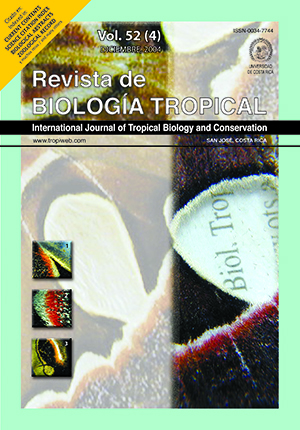Abstract
The common Spanish name of the moth Rothschildia lebeau (Saturniidae) is cuatro ventanas (four ‘windows’), because it exhibits a transparent oval path in each wing. The scales of the colored areas and the bristles from the “window” were analyzed. We developed a simple device to measure transmittance across the “windows” with an spectrophotometer. A square section of “window” was mounted onto a flat black card and placed onto a clamp that hung in the path of the light - beam of the spectrophotometer. Absorbance was measured at 350 and 550 nm, with the “window” positioned perpendicular to the light beam (incidence of 90°); then the measurements were repeated with the “window” moved at an angle of 45°. Each measurement was replicated 5 times. Wing color spots were analyzed with a light dissection microscope (stereoscope) and with scanning electron microscopy. The scales have a minimum of 4 morphological types, 3 of them showed the typical appearance of unspecialized scales described for other butterflies; whereas the fourth has features particular to this species. On the “window” the scales are transformed in hair-like bristles that do not interfere with light, conferring the transparency that characterizes the “windows”. However, if the wing is illuminated at an almost grazing-incidence, they reflect the light as a mirror. Two hypothetical functional explanation for the windows are mimicry and interspecies communication
References
Ghiradella, H. 1985. Structure and development of iridescent lepidopteran scales: The Papionidae as a showcase family. Ann. Entomol. Soc. Am. 78: 252-264.
Ghiradella, H. 1994. Structure of butterfly scales: Patterning in an insect cuticle. Microscop. Res. 27: 429-438.
Ghiradella, H. 1998. Hairs, bristles, and scales. In Microscopic anatomy of invertebrates. Vol 11A Insecta. p. 257-287.
Ghiradella, H. 1999. Shining armor: Structural colors in inscects. OPN 10: 47-48.
Janzen, D.H. 1984. Weather-related color polymorphism of Rothschildia lebeau (Saturniidae). Bull. E. S. A. 16-20.
Laurence, C., P. Vukusic & R. Samples. 2002. Grazingincidence iridescence from a butterfly wing. Appl.
Optics 41: 437- 441.
Sweeney, A., Jiggins C. & Johnsen S. 2003. Polarized light as a butterfly mating signal. Nature 423: 31-32.
Vukusic, P., J.R. Samples & H. Ghiradella. 2000. Optical classification of microstructure in butterfly wingscales. Photonic Sci. N. 6: 61-66.
Vukusic, P., J.R. Samples, C. Laurence & G. Wakey. 2001a. Sculpture-multilayer optical effects in two species of Papilio butterfly. Appl. Optics 40: 1116-1125.
Vukusic, P., J.R. Samples, C. R. Laurence & R. J. Wootton. 2001b. Limited-view iriescence in the butterfly Ancyluris meliboeus. Proc. R. Soc. Lond. 269: 7-14.
Vukusic, P. 2003. Sambles. Photonic structures in biology. Nature 424: 852-855.
Vukusic, P. 2004. Natural Photonics. Physics World. (February): 35-39.

This work is licensed under a Creative Commons Attribution 4.0 International License.
Copyright (c) 2004 Revista de Biología Tropical

